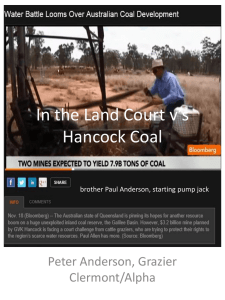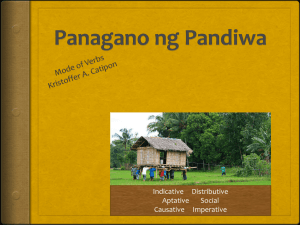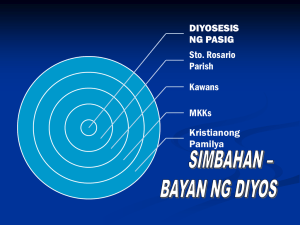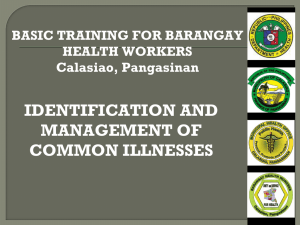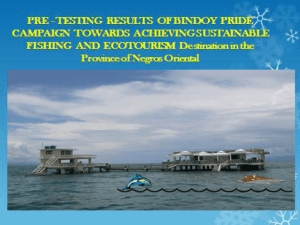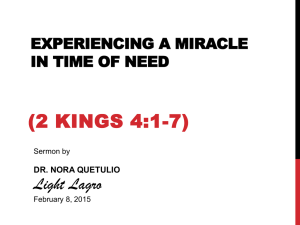video documentary on the denr's enr-community enterprise
advertisement
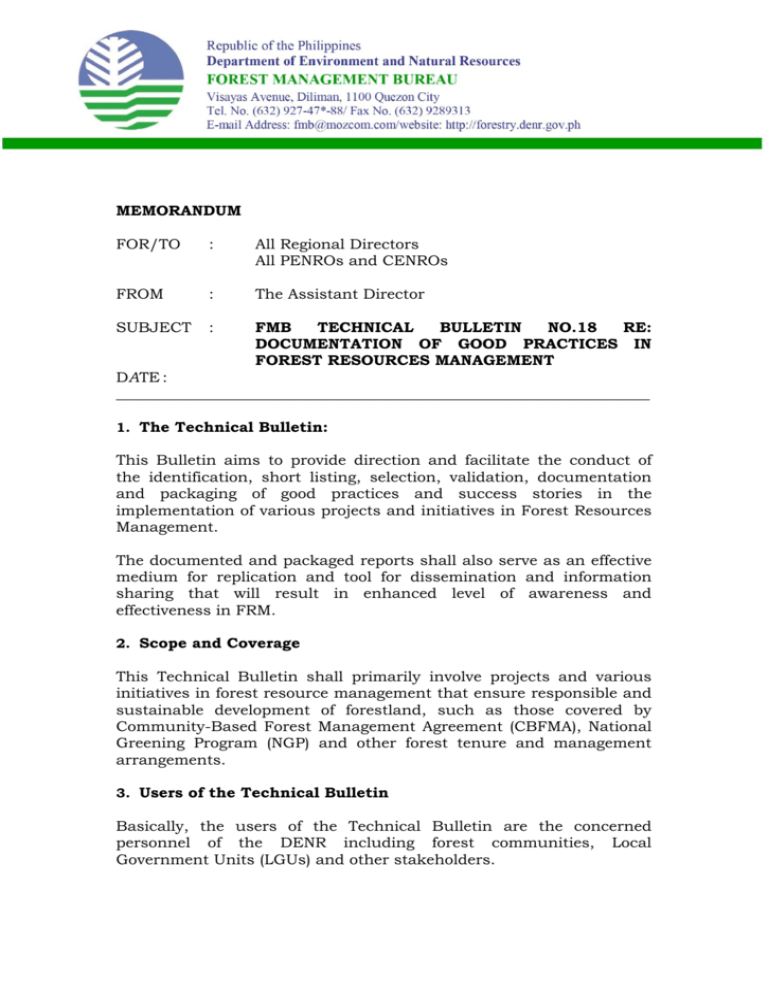
MEMORANDUM FOR/TO : All Regional Directors All PENROs and CENROs FROM : The Assistant Director SUBJECT : FMB TECHNICAL BULLETIN NO.18 RE: DOCUMENTATION OF GOOD PRACTICES IN FOREST RESOURCES MANAGEMENT DATE : _____________________________________________________________________ 1. The Technical Bulletin: This Bulletin aims to provide direction and facilitate the conduct of the identification, short listing, selection, validation, documentation and packaging of good practices and success stories in the implementation of various projects and initiatives in Forest Resources Management. The documented and packaged reports shall also serve as an effective medium for replication and tool for dissemination and information sharing that will result in enhanced level of awareness and effectiveness in FRM. 2. Scope and Coverage This Technical Bulletin shall primarily involve projects and various initiatives in forest resource management that ensure responsible and sustainable development of forestland, such as those covered by Community-Based Forest Management Agreement (CBFMA), National Greening Program (NGP) and other forest tenure and management arrangements. 3. Users of the Technical Bulletin Basically, the users of the Technical Bulletin are the concerned personnel of the DENR including forest communities, Local Government Units (LGUs) and other stakeholders. 4. FRM Good Practices as defined in this Bulletin FRM Good Practices refer to forest resources management practices and technologies that are innovative or indigenous that can serve as models for “green and inclusive growth”1. These are cost-effective and may be replicated focusing on its social, economic and environmental relevance. 5. Procedures in the Documentation of Good Practices 1. Identification of FRM good practices for documentation. The CENRO concerned shall select three (3) potential good FRM practices within their jurisdiction based on profiles (Annex A) and set of selection criteria and indicators (Annex B). 2. The absence and presence of each indicator per major criterion shall determine the three (3) good practices to be selected. The indicator that meets the minimum number of seven (7) checks (√) in each major criterion in the left portion of Annex B. must be considered that has the best features and characteristics of FRM good practice to be selected. 3. The documentation of good practices shall follow an outline for a storyline/plot as presented in Annex C and further guided by questions enumerated in Annex D. 4. The documentation of good practices shall be a continuing activity of the Region. The Region shall come up with at least one (1) documented good FRM practices per year, which can be increased depending on the availability of funds for the purpose. 6. Packaging of CBFM Good Practices 1. The narrative documentation should be complemented with audio-visual presentation for more effective sharing and learning of good practices. 2. The conduct of audio-visual documentation activities may either be done by the Region produced by tenure holder or through outsourcing (by contract). 3. In case of outsourcing of audio-visual documentation activities, the following shall be observed: 1 Green and Inclusive Growth is the inclusion of marginal farmers, fisherfolks and large number poor of households into the whole development activities on the value chain for mutual benefits. (LatinAsia 2014) 3.1. A maximum of 15 minutes video documentary shall be allowed. 3.2. The processes, outputs and templates provided herein shall be the minimum Terms of Reference (ToR) to be used in the procurement for this subject undertaking. 3.2. The Regional Public Affairs Office (RPAO) under the Office of the Regional Director, PENRO and CENRO shall provide necessary supervision and guidance in the entire process of audio-visual documentation activities. 3.3. The Region shall periodically assess the progress of documentation activities as guided by the said ToR. For this, the Region shall create a review committee composed of representatives from the concerned offices/units of the Region, PENRO and CENRO. 7. Disseminating and Sharing Good Practices 7.1. The following are the three main methods dissemination/sharing of Good Practices, to wit: of 7.1.1. Publication The Region thru the RPAO shall come-up with a publication that shall be entitled “Regional FRM Good Practice Series”. The RPAO shall maintain the annual publication that will highlight the “Good Practices” to foster promotion of learning and sharing of experiences. 7.1.2. Regional Office Website The Region shall utilize the Regional Office Website to promote and share the “Regional FRM Good Practice Series”. The web page shall include a summary database on all “Good Practices”. 7.1.3. Distribution of CD-ROMs on “Best Practices” Video materials on FRM Good Practices shall be produced in CD-ROMs copies that shall be disseminated during national and Regional conferences, workshops and fora. 7.2. Distribution to interested walk-in clients of the DENR at the Central and Field offices. Further, clarifications and/or supplemental guidelines may be issued to enhance the effective and efficient documentation of Good Practices. FOR GUIDANCE OF ALL CONCERNED. FOR. MAYUMI QUINTOS-NATIVIDAD Assistant Director In-Charge, Office of the Director Annex A. PROFILE/BRIEF PRACTICES 1. DESCRIPTION OF IDENTIFIED FORESTRY FRM Description Name of the Peoples Organization a. Name of PO Chairman b. Number of Tenure Instrument c. Area coverage (hectares) d. Date of Issuance e. Date of Community Resource Mgt. Framework (CRMF)/ Development Plan Affirmation f. Date of Five-Year Work Plan (FYWP)/Development Plan Affirmation g. Location h. Number of beneficiaries: Male ______; Female _______ 2. Type of Forest Resource Management Good Practice/PO/Community Initiatives/ Interventions (Please describe) 3. Management Set-up 4. Implementing Scheme/Developmental Activities 5. Target Results Achieved (Social, Economic and Environmental Dimension) How many are benefiting from the project, how they improved the lives of the people/community, project area. Describe the before and after situation/scenario 6. Challenges and Opportunities - Problems, Issues, Needs Opportunities (PINOs) 7. Lessons Learned 8. Potential for Replication/Scheme/Strategies 9. Cost/Benefit Ratio and Analysis - Cost Effectiveness & Annex B. SELECTION CRITERIA/ INDICATOR WEIGHT Social functional and membership supporting to sustain the project for the last five (5) years Existence of functional body to operate the project ( e.g with strong leadership and good relationship with other PO members and DENR/LGU in managing community finances, extending marketing assistance, acting as bookkeeper); to its members including indigenous community other government agencies and NGOs for necessary support/assistance (marketing, product development, capability building) ent with the development priorities of the LGU; with technical changes and challenges encountered in the implementation of the project Economic -ups with buyers and traders - Informal - With formal arrangement expansion area (as other source of raw materials) producers and consumers adding mployment opportunities from the livelihood venture (labor for project activities prior to harvesting/production e.g. infrastructure development livelihood/enterprise activities and spent for other project-related - Willingness and availability of share capital among the members - Availability of PO funds Environment areas dopted and implemented soil and water conservation measures on forestry rules and regulations ities/technologies (e.g. composting among others) -diversity, flora and fauna Practiced Climate Change adaptation and mitigation strategies Conduct research and technology development activities Annex C. OUTLINE OF THE STORYLINE/PLOT I. Introduction - Brief background of the good practice: provide important statistics if appropriate - human interest angle to anchor the story and make it more real and will catch the attention of the reader/audience impact II. Situation on the Ground prior to the project - bio physical characteristics of the area - existing vegetation - problems encountered/challenges before the forest resource management projects - accomplishments/gaps - how the association/group formation/how intervention started III. Interventions - specific interventions that showed concrete results quantity and quality assistance provided various supports/assistance generated IV. Success Strategies and Lessons Learned - Activities conducted: attended by various stakeholders partnership achieved Impacts (HIGHLIGHT THIS – Social, Economic and Environmental) V. Challenges/Call to action - - Current challenges (challenges being encountered and addressed while implementing the ______) Continuing challenges: how to ensure that stakeholders will continue to embrace it (changes in leadership, how deeply ingrained/embedded in the principles of sustainable development) Outline of on-going and future commitments Recommendations Annex D. GUIDE QUESTIONS IN THE IDENTIFICATION AND APPRAISAL OF COMMUNITY-BASED FOREST MANAGEMENT PRACTICE URI NG PROYEKTO SAAN MATATAGPUAN TAGAPANGASIWA : ___________________________________________ : ___________________________________________ : ___________________________________________ Pangunahing Katanungan • Pakikwento kung paano nagsimula ang iyong proyektong panggugubat? Ano ang layunin ninyo sa pag tatatag nito? • Paano ninyo isasalarawan noong inumpisahan pa lang ninyo ang proyektong panggugubat kumpara sa ngayon? • Anu-anong mga likas yaman ang matatagpuan sa panggugubat na pook at sa kalapit na pamayanan na ginamit sa proyekto? • Paano natukoy at napili ang mga kasapi sa proyekto? Ano ang mga pamantayan at mga kinakailangan na dapat matugunan ng mga kasapi? • Gaano karaming oras ang ginugugol sa proyekto? • Ano ang inyong binitiwan? Bakit kailangan mo itong bitiwan para sa proyekto? A. Panglipunan at Kultural • Aktibong kasapi o Ilang miyembro ang direkta at hindi direktang nangangalaga sa inyong proyekto? o Paano nahahati-hati ang mga responsibilidad ng bawat kasapi? • Pagkakaroon ng aktibong pamunuan upang mangasiwa ng proyekto? (Halimbawa, mayroong kasapi na siyang nagsasagawa ng pagpapalago at pagpapanatili ng mga taniman, nangangasiwa ng mga gawain sa pananalapi, nagbibigay ng suporta sa proyekto, tulad ng tulong sa pagmemerkado, at iba pang teknikal na tulong). o Sino-sino ang mga pangunahing kasapi na nangangalaga sa bawat bahagi ng proyekto, paki paliwanag ang tungkulin ng bawat meyembro at opisyales base sa inyong nabuong organisasyon. o Maari mo bang isalarawan ang sistema o pamamaraan ng pananalapi sa inyong pangkalakalang organisasyon. o Ang organisasyon ay nagbibigay ng pananalapi o technikal na tulong sa kanyang mga kasapi o Anong mga tulong o supporta ang ibinibigay ng samahan sa mga kasapi? o Mayroon bang bahagi ng kita sa pangkabuhayan na ipinamamahagi sa samahan? • Pagkakaroon ng mga kinakailangang teknolohiya, kasanayan at kaalaman ukol dito at paano ito ginagamit. o Ano yung kakayahan ng mga kasapi sa pagsagawa o pangangasiwa ng proyekto? o Ang inyo bang organisasyon ay mayroong kasanayan at kaalaman upang makapagpabunga, makagawa, at makagamit ng akmang teknolohiya, mga kagamitan at iba pang mga kinakailangang kagamitan o Anong mga dapat na kinakailangang kasanayan at teknolohiya? o Anong mga polisiya o patnubay para sa pangangasiwa ng proyekto? o Ano pa ang posibleng pakikibahagi sa proyekto? (bahagi o kasapi sa iba pang samahan, institusyon, gawain sa labas ng proyekto) o Saan kayo nadadalian? Saan kayo masaya? o Saan kayo nahihirapan sa mga gawain sa proyekto? Anong maaring gawin para mapadali ang mga ito? o Anong mga kalakasan, kahinaan, oportunidad at banta sa pagsakatuparan ng proyekto? B. Ekonomiya • Napagkasunduang Pamamaraan ng Pagbabahagi ng Benepisyo; o Mayroon bang pamamaraan ng pagbabahagi ng bawat biyaya/kita sa pagsasagawa ng proyekto, paano isinasagawa o pamamaraan sa pagsasagawa? • Napanatiling pakikipag-ugnayan sa pag mamarket o Sino-sino ang mga bumibili o saan ipinagbibili and mga zz nmprodukto sa pangkabuhayan? o May mga kasunduan ba kayong pormal? (Kung wala, sa anong paraan) • Pagkakaroon ng karagdagang lugar o May plano ba para sa pagpapalaki ng proyekto? Kung mayroon, may lugar pa ba para dito? o Anong kadahilanan o mga oportunidad bakit kailagang magpalaki pa ng lugar para sa produksyon at mismong pangkabuhayan? • Kakayanan ng merkado na tangkilikin ang produkto o Anong tantya nyo sa merkado o pangangailangan sa produkto? o Natutugunan ba ang kagustuhan at pangangailangan ng mamimili? o Sa palagay ninyo ba ang pag-aaral ng merkado ay makakatulong? • Karamihan sa kasapi ay gustong maging manggagawa ng proyekto. Sa pagpapalaki ng proyekto, ilang kasapi ang kinakailangan? • Kagustuhan ng karamihan sa kasapi na mag bahagi ng karagdagang kapital o May pinansyal na kakayanang mag bahagi ng kapital para sa pag papalawak ng proyekto? Sinong mga meyembro ang gustong mag bahagi ng kapital kung sakali? • Ang samahan ay nakapagsagawa na ng mga pakikipagugnayan sa iba pang ahensya ng pamahalaan at ng pribadong institusyon.; o Maliban sa DENR, anong mga institusyon ang tumulong sa pagsasagawa ng iyong proyekto? • Ang proyekto ay umaayon sa mga pangunahing layunin at gawain ng LGU; o Hangganan ng pagbibigay ng suporta ng LGU? Anong mga uri ng tulong ang ibinigay nito? Kagustuhan ng LGU na tumulong sa proyekto • C.Pangkalikasan • Ang kasalukuyang proyekto ay may kinalaman o tumutugon sa sa mga kinakailangan sa pagpapanatili ng likas na yaman; o Sa anong paraan nakakatulong ang proyekto sa pangangalaga at pagpapanatili ng likas na yaman? o Mayroon bang mga dumi o mga patapon na bahagi mula sa likas yaman? Mayroon bang mga gawain na maaari pang magamit o mabawasan ang mga dumi o kalat. (halimbawa dumi ng hayop na maaaring pataba sa mga pananim, pinagputulan/retaso ng kahoy na maaaring maging pang dekorasyon, lalagyan o suporta ng mga litrato at iba pa)
